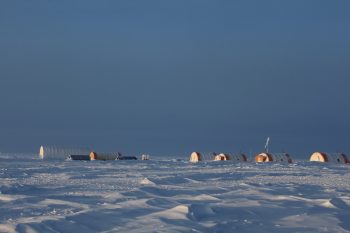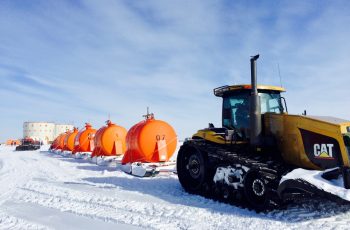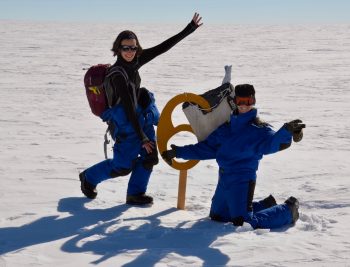Dr. Carole Dangoisse was the ESA-sponsored medical doctor spending 12 months at Concordia research station in Antarctica. She facilitated a number of experiments on the effects of isolation, light deprivation, and extreme temperatures on the human body and mind. In the following post, Carole discusses life in Antarctica.

A lovely summer’s day. Credit: ESA/IPEV/PNRA-C. Dangoisse
During the summer, the main limiting factor to exploring the grounds, apart from finding time, is acclimatization to the altitude. Our polar suits allow us to stay outdoors for extended periods, despite the cold.
I first enjoy the thrill of getting a bird’s eye view of Concordia station by climbing the “American tower”, a 45-metre metal structure about half a kilometre away from the station, and on which several weather instruments have been fastened at various heights.
The view from above is absolutely wonderful and awe-inspiring. It is as though you were standing above a sea of ice, with wave upon wave rippling to the horizon. When you turn your back to the station, the panoramic view is that of a vast expanse of cold whiteness, undisturbed by any sign of life whatsoever, void of anything other than snow…. The sight of such endless ice almost feels crushing.

The caterpillar truck. Credit: ESA/IPEV/PNRA-C. Dangoisse
My next trip is to a weather station located approximately 25 kilometres from Concordia. There are six of us in the caterpillar truck. We have all eagerly jumped at the chance to venture a little further out on the continent, for just a few hours. The ride out is nice – we all watch the station getting smaller and smaller, and ultimately disappear completely from our view. We get to appreciate a little what it is like to be an adventurer lost in the middle of the continent.
After about an hour of bumpy riding, we finally spot the instruments. What a relief for our glaciologist and chemist to see that the wind has not blown away the devices, or snow buried them! Whilst he downloads all the data on a computer, we measure the height of numbered wooden pickets inserted in the snow at regular intervals. We can deduce the snow accumulation over one year by comparing our height records to the previous year’s figures.
The way back is rougher and nausea inducing. Bad weather is settling in, the visibility becomes extremely poor and the drivers lose the track, relying instead on GPS and cutting across barren fields. But the whole expedition was definitely fun!
Lost keys

The wooden keys. Credit: ESA/IPEV/PNRA-C. Dangoisse
My last big trip of the summer is a Sunday walk to “The Keys”, along with Claudia and two summer campaigners. Rumour has it that one of the raid drivers once lost his keys, dropping them in the snow. As a whimsical nod to this, a previous crew fashioned huge wooden keys and hid them “under the mat”, a little more than 4 km from the station, should anyone else lose theirs.
It is a pleasant -30°C, and we end up removing the top of our polar suits, walking in t-shirts. We stop for some cookies and warm tea once at the keys and venture out a little further. A 10 km walk, at the altitude we are at, in the cold and wearing an extra 10k of clothes plus a safety bag ends up being a more strenuous exercise than I had thought it would be. But it feels so good to stretch our legs a little!




Discussion: 2 comments
Cool story
Thank you for sharing all this with us! Thinking that I refuse to walk more than a few minutes in our “oh, so bitter cold” (-7 C), I don’t even try to imagine a 10 km walk with -30 C!!!!
And you should make merchandise from that wooden key 😀 The picture is so cute!
I envy you for that panoramic view you wrote about. But I don’t feel well being away from home for more than a few days, so my antarctic-experiences have to be made through your eyes. Sorry for these completley non-scientific words, but I am no scientist – I am just very interested in what you do.